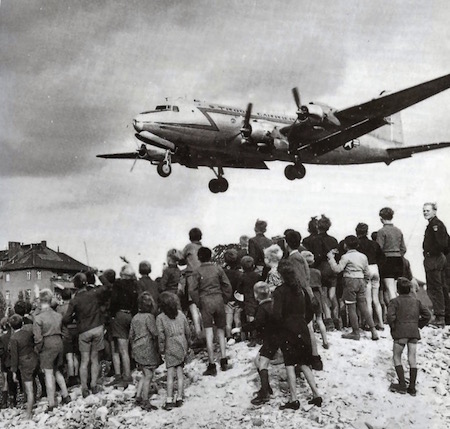The first major international crisis of the Cold War happened in Berlin between April 1948 and May 1949, known as the Berlin Blockade. During these long months, the Soviet forces blocked the Western Ally’s railway, road, and water access to Berlin.
And in response to the blockade, the Berlin Airlift came to be.
The Soviet forces were unhappy when the Deutschmark was introduced in West Berlin. They were so dissatisfied with the currency change without their consent that the Soviet troops issued orders to restrict traffic between the American, British, and French occupation zones of Berlin.
Because of that, no cargo could leave Berlin by rail without permission from the Soviet Forces.

How the Berlin Airlift came to be.
On June 18, 1948, the Deutsche Mark was introduced in West Germany. The next day, Soviet Forces halted all passenger trains and traffic on the autobahn to Berlin. To enter Berlin, you needed special Soviet permission. To leave the city, you needed another one.
On June 22, the Soviets announced they would introduce the Ostmark and started a massive propaganda campaign condemning Great Britain, the United States, and France by radio, newspaper, and loudspeaker.
In the following days, everything got worse, and the Soviet forces stopped supplying food to the non-Soviet sectors of Berlin. Electricity was also cut, and the future of West Berlin looked grim. At that time, west Berlin had around 36 days’ worth of food and 45 days’ worth of coal, which had to be fixed somehow.
This is how the Berlin Airlift came to be. Soviet Forces believed this blockade would weaken the Western Allied Forces but failed to do anything besides join them closer together. On June 24, the Berlin Airlift started, and West Berlin began to be supplied with food, milk, coal, and everything else it might need via airplanes at the Allied Airports of Tempelhof, Gatow, and Tegel.
By the end of August, Berlin was being supplied by the airlift with more than 1,500 flights a day that delivered more than 4,500 tons of cargo, enough to keep West Berlin supplied. We even wrote something about the crane that helped send coal to warm up houses in West Berlin.
The video above is called Berlin Airlift: The Story of a Great Achievement and was produced by the Central Office of Information to document and keep track of the amazing and extraordinary events of 1948 and 1949 when Berlin was fed daily by thousands of airplanes.
To learn more about the Berlin Airlift, read this article on Wikipedia or The Blockade Breakers: The Berlin Airlift. If you want to see some nice pictures, try the Berlin Airlift: Air Bridge to Freedom: A Photographic History of the Great Airlift.